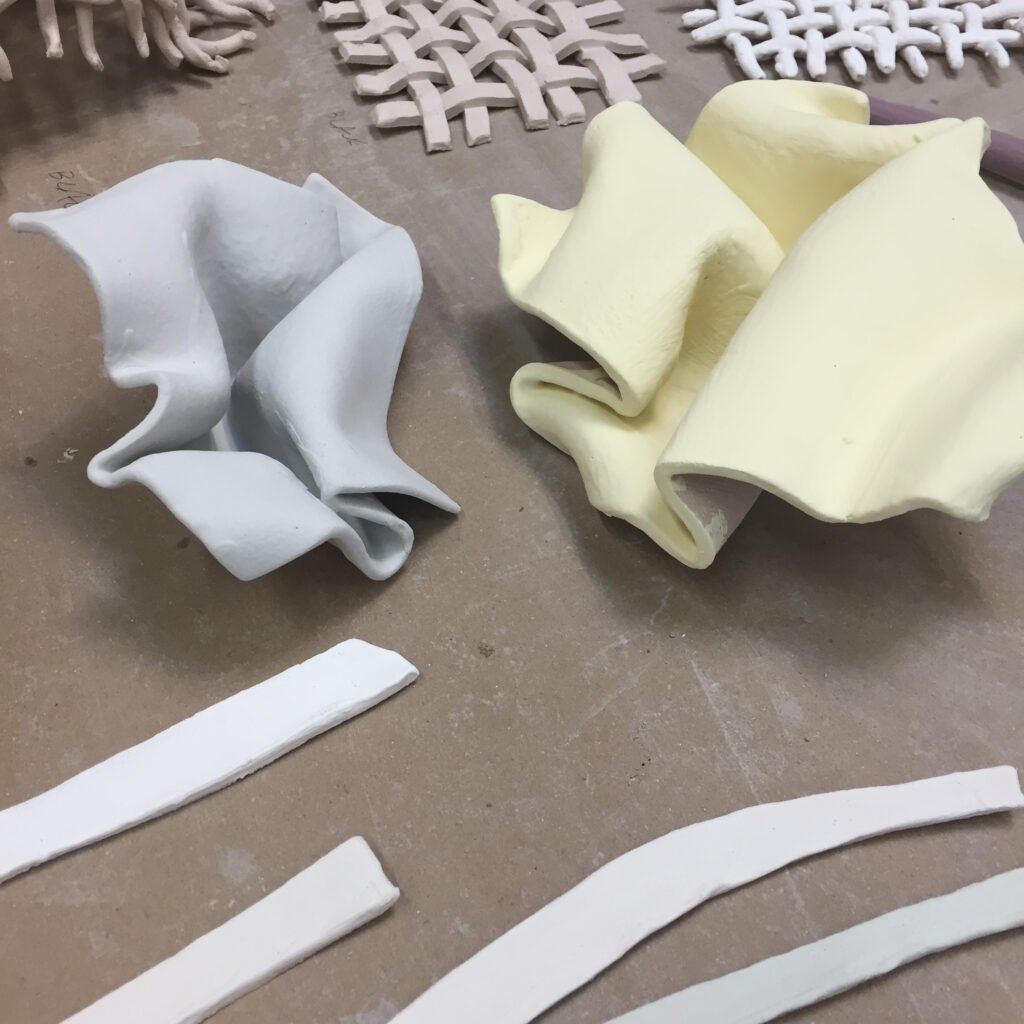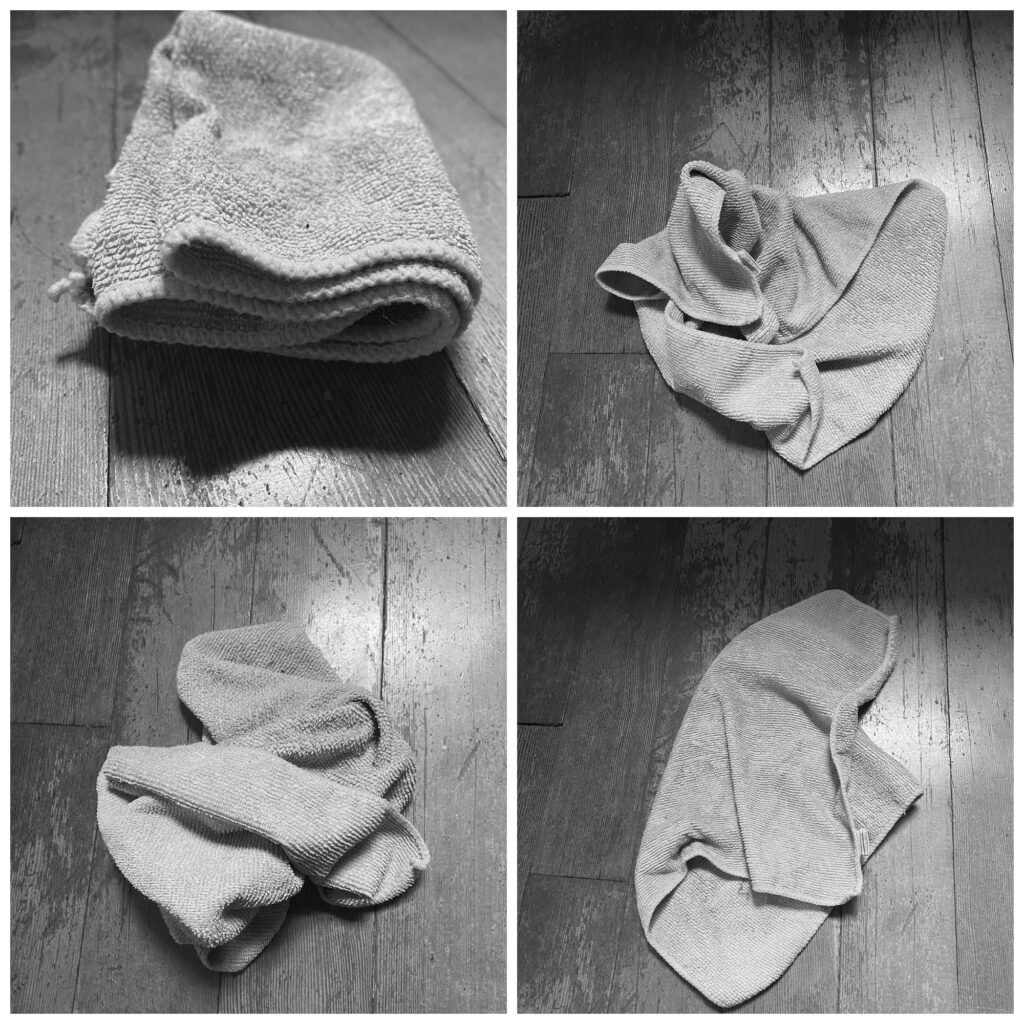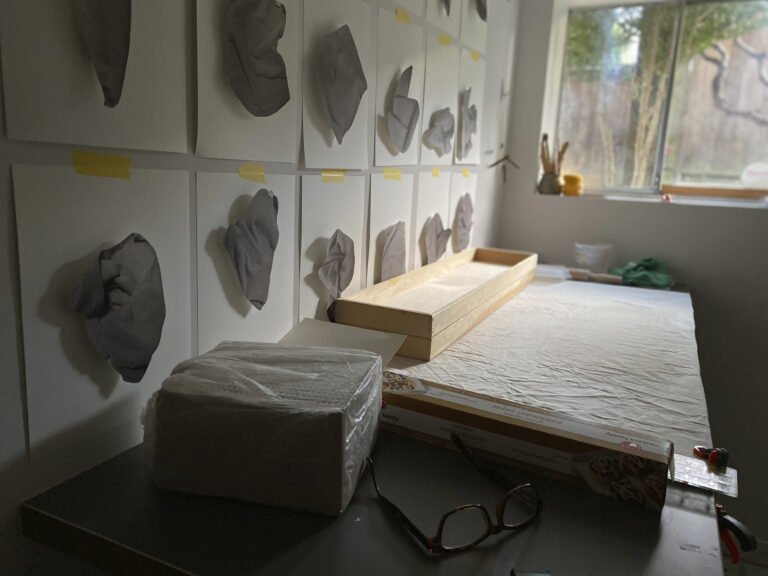Amanda Wood tells us about how her latest exhibition started with a single microfibre cloth and grew into a multi media exploration. With a seemingly mundane house hold item, Amanda interrogates the medium she knows so well and turns up a series of works demonstrating the vibrancy and complexity of cloth. She shows us that there is always more to learn and often knowledge of a particular subject is found outside the subject itself. Amanda’s exhibition INTERWOVEN is on view in our gallery until August 19, 2021.
On the floor by the back door on its way downstairs to the laundry room was a single crumpled microfibre cloth. An ordinary thing, defined as much by its use as by its mundaneness. By lunchtime it was joined by another and by the end of the day there was a pile of similar, slightly damp, slightly dirty cloths that had been tossed in an offhand sort of way.
“they appeared like memories of actions, worries, hopes and boredom”
Day after day, week after week, these cloths would be piled up slowly, then gathered, washed, dried, folded and returned to the linen closet only for the whole cycle to be repeated the next day. It was a way of keeping time when timekeeping was meaningless. After weeks of this, I started to notice the repetition in the forms – they appeared like memories of actions, worries, hopes and boredom shifting as cloth will and resembling something unclear but a little familiar.
I started photographing them with my phone and wondering why I was captivated by these curves, and folds. There was something there, but I didn’t quite know what it was. A sense of kinship maybe, something universal, but also mundane and mass produced. How could there
be anything interesting in something mass produced? The build-up of photographs like the pile of actual cloth showed me a language or an alphabet of repeating symbols. The darkness hidden in the folds seemed important.


It’s difficult to untangle my thinking about cloth from my experience of working with it. My body holds tactile memories of different threads that influences both thinking and making aspects of my practice. Weaving takes time. It is an extension of my body. Through the movement of my hands working with every thread, slowly building cloth, repetition and
responses to materials determine the outcomes and my thoughts build along with the cloth.
Different materials require a different touch, and an understanding of who they are. Cotton is like a sturdy pair of jeans, meant for function but still vulnerable to a rough treatment – as a thread it tangles easily so it needs a firm structure and tension but too much and it will snap. Silk is deceptively strong. We think of it as light, delicate and gossamer, but it rarely tangles like cotton, the slipperiness and stretch of the threads require a different type of attention and it offers forgiveness in the process. I am often captivated by the character of the materials I work with, and I wondered if I could somehow capture that character as well as the temporal nature of what I saw in these photographs in other tactile media. What qualities would be introduced with these new materials and processes?
I set up a small studio in my home where I could play with processes that captured my imagination. I started with clay. In 2019 I participated in a skills exchange with local ceramicist Grace Lee. I remembered how challenging it was for my body to understand the motions needed to push the air out of fresh clay and the way the clay felt in my hands, so unlike the silk or cotton that I usually work with. The clay pieces are at the centre of the experiments I’m sharing in this exhibition. I looked for ways to capture the folds, the cavities, the shapes of crumpled and folded cloth in porcelain. Time was frozen in these pieces. I was able to hold shape and turn it over, revealing the undersides, the interiors and I found another layer to my
cloth alphabet.
I then shifted my little studio into a printmaking space and played with recycled cotton paper and handwoven studies on a little teaching press. The inability to travel, to learn from mentors, to share work felt limiting at first but then became a gift as the small-scale allowed me to try many more ideas, do things intuitively rather than by learning them through demonstration. The outcome is a series of relief prints made without ink that capture the strength and vulnerability of a thread in both tangled and woven form.

With the introduction of line as well as form in the prints, I was curious to see if I could combine these qualities to further understand tactility in cloth. In a small makeshift darkroom light leaks influence the outcome and limited space means that I can only make small prints. Like weaving,
darkroom printing requires precision and technique. Eliminating the camera allowed me to focus the technique and skills needed to work in a tactile way to develop an idea that I had begun at a residency in 2019. Working in the dark heightened the tactility of the cloth I was arranging on the photosensitive paper. Like the microfibre cleaning cloths that began this process, this cloth was also discarded – curtaining and netting that I had picked up at a thrift store a few years ago. Floating, textural forms seemed to defy gravity and time as they simultaneously appear in multiple places in shifting folds that move in and out of focus, flattening and turning the darkness of the folds into brightness. Revealing that darkness that I
had first noticed in the microfibre cleaning cloths.
Working through these processes, letting them unfold as they will and shifting from one to the other when it seems right has been both a solution to feeling distracted and a way to return to things that delight and surprise me. The connections between the materials grow the more that
I engage with the pieces. They demand a slow and careful response. A sense of play and experimentation has returned to my studio and these studies capture a specific time, a deeper understanding of cloth and a return to beginner’s mind.
I often seek fluency in material languages through practice, and repetition. In this moment, I wanted to shift my thinking and create new possibilities by changing the rules and exploring unfamiliar processes and materials. In doing so, I found a state of unknowing, a place where forms could emerge as they were. This place and this approach became as insightful as any path towards mastery of form or material.

